Adaptive Multivariate Testing Boosts Profits Faster
Self-learning conversion rate optimization beats old school method by 100 to 1
Conversion rate improvements need to be delivered faster these days, too fast to rely on yesterday’s testing methodologies, “best practices” and guideline guesswork. One answer has been custom multivariate testing: that is of course, if you have high site traffic and a generous budget. Google’s free, easy Web Site Optimizer (WO) made multivariate testing more popular. But most small to midsized companies lack sufficient site traffic to produce statistically significant results for many months with WO. So how can these smaller companies compete? WebSiteOptimization.com has the solution.
The WSO Solution: Adaptive Multivariate Testing
WSO’s new adaptive multivariate testing methodology is able to boost conversion rates right from the start, even during the testing period. Our self-learning method adapts to visitor traffic in real time and after a very brief learning period starts to consistently test only those page impressions that are better than the control. This means that you can start making more money immediately.
If you’re part of a small to mid-sized company with normal web traffic you probably spend good money each month on improved SEO (Search Engine Optimization). Great, you’re getting more prospects “in the door.” But what percentage are you closing? Without a proven way to turn those prospects into customers you’re just throwing your SEO money away (not to mention all the other investments you’ve made in your Web presence). That’s why you need WSO’s Adaptive Conversion Rate Optimization: it’s the only proven solution that can cost-effectively turn web leads into sales for small to mid-sized companies. The best part is: you’re only a brief interview away from the higher profits you’ve been working so hard for. So don’t wait a minute longer. Call us at (877)-SITEOPT (877.748.3678) or contact us and ask to speak to our Adaptive Conversion Rate Optimization team leader.
What Is Multivariate Testing?
Multivariate testing pits different variations of your content against each other, to prove which combinations best convert prospects into buyers. Multivariate testings allows you to test different combinations of headlines, calls to action, layout, and color treatments to maximize the conversion rate of your landing pages.
Not All Multivariate Testing Methods Are Created Equal
The advantage of multivariate testing lies in is its ability to test large numbers of page versions while varying many elements at the same time. Before adaptive multivariate testing, there were only two main multivariate testing methods: full factorial, and fractional factorial. These older methods have an Achilles heel; they require large numbers of web visitors to suggest significant conversion rate improvements. Let’s take a closer look at these older methods.
Full Factorial Method
The full factorial method is a fancy name for ‘test all combinations and find a winner.’ This is a brute force approach used by Google’s Web Site Optimizer and other approaches.
- Number of page combinations – By choosing to test two elements of your landing page by assigning three different variations to each one of them you will create a total of 16 possible page combinations
- Adding more elements to the test will dramatically increase number of combinations. For example, a test with five elements with three variations each will generate 1,024 combinations (4x4x4x4x4).
To compare the different optimization methods let’s illustrate the number of visitors required for a full factorial testing of two variable elements. Each variable is represented by its own axis, and the total number of visitors needed to perform this test is represented by the cube below:
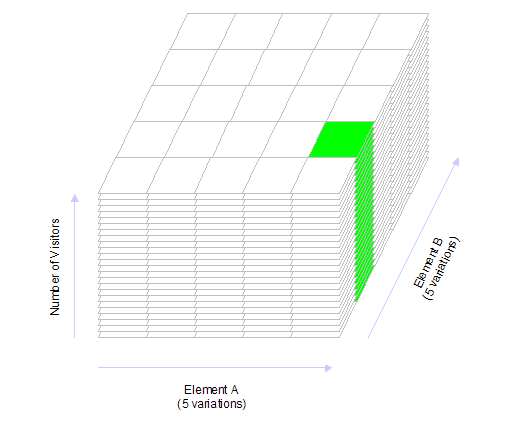
The full factorial method has its advantages and disadvantages:
Pros
- A free tool – you can use the free Google Website Optimizer
- Reliable results – there is no question about which page combination is the best: you’ve tested them all
Cons
- Prohibitive traffic requirements – Since every element must be considered and tested a large amount of data (time) is necessary to achieve results. How many months can you keep management happy with “no results yet, we’re still testing?”
- Limited scope – to make it practical, and to avoid web visitor limitations, companies are forced to run very small tests with very few variable elements; limiting freedom of exploration
Fractional Factorial Method
A more sophisticated and more expensive method is the so-called fractional factorial method. Instead of testing all possible page combinations, only a subset is tested and mathematical modeling is used to predict the overall combination winner. This method is very sensitive to potential interactions between different elements. That is why several waves of testing are necessary before good results are achieved.
The picture below illustrates the reduced number of web visitors required by this methodology.
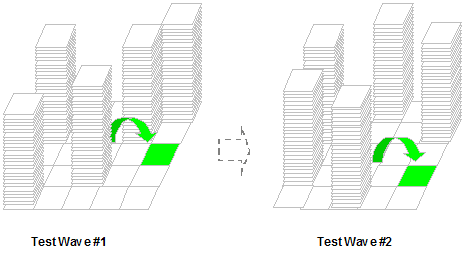
Pros
- Ability to test a large number of element combinations – use of mathematical modeling in combination with effective test array design – makes it possible to effectively evaluate a large number of page elements and element variations
- Quick learning – After each wave of testing, a marketing professional can learn about the importance of each element enabling a more iterative approach to testing.
Cons
- Sensitivity to element interaction – The ideal use for this methodology is one where the impact of each page element is independent from all others. Unfortunately, in real life scenarios one variation often works better in combination with another element variation, requiring waves of iteration.
- Requires large number of visitors – Each wave of tests must be run until a statistical confidence is achieved, meaning that the number of required visitors escalates – making this method not feasible for mid to small websites (MVT vendors typically require >100,000 visitors/month).
- Requires expert knowledge – designing test arrays and analyzing test results requires specialized multivariate testing knowledge
- High price – the existing fractional factorial solutions tend to cost thousands of dollars per month.
Clearly these older methods have too many drawbacks to make them practical for small to mid-sized companies without a huge amount site traffic. The best solution for them is the WSO solution: Adaptive Multivariate Testing.
Adaptive Multivariate Testing Method
The adaptive method moves multivariate testing to an entirely new level. The main advantage of this method is its ability to adapt to visitor behavior in real time while converging toward the winning page combination. Actual testing is initialized by presenting a few random page combinations to live visitors. Visitor reactions are then processed in real time creating statistical data that is used by the adaptive algorithm to generate a new page combination that will be shown to live visitors. During this iterative process, the adaptive algorithm is able to effectively detect elements that impact page conversion in positive way and to filter out elements that have a negative impact. The bottom line; a far quicker, less expensive path to web site success.
The picture below illustrates the adaptive method and its ability to effectively converge on the best page combination with a dramatic reduction in the required number of web visitors.
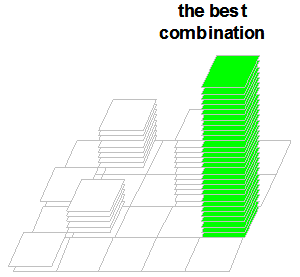
- The adaptive method effectiveness is achieved through continued learning and a self-correcting loop. Unlike the outdated fractional factorial method where mathematical modeling sits and waits until a full array of page combinations are accurately tested (weeks of time and many thousands of prospects not converted into customers), the adaptive method continually learns and adjusts.
- The foundation of this method is based on the well known gradient search technique. “Gradient” is a mathematical term that measures the angle or ‘steepness’ of the line or curve at a certain point. Applied to the website optimization problem, continued gradient calculations help find in real time if a sequence of two or more page combinations are creating ascent (converging toward the better performing combination), descent (going toward lesser performing combinations) or staying flat (no improvement).
Adaptive multivariate testing embodies the best aspects of other two methods: the exactness of results achieved through full factorial testing and reduced number of web visitors produced by fractional factorial methods.
Pros
- Ability to test a large number of elements (combinations) with a minimum number of web visitors – The adaptive method requires orders of magnitude fewer visitors than any other solution making it possible for mid to small websites to effectively run reasonably large multivariate tests
- Increases overall conversion even during the test itself – After a brief initial training period the algorithm is able to start converging towards the best solution while consistently testing page combinations that are better than the control. As a result, the conversion rate of the entire test, meaning cumulative conversion of all page combinations that participated in the test, will be better than the control
- No need for expert knowledge – The adaptive algorithm will perform the search for you. You do not need to know anything about the design of multivariate testing arrays.
- Affordable pricing – WSO’s service is delivered at price points that are easily acceptable for company of any size
Superior Results
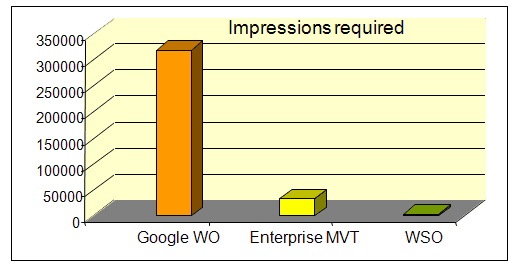
To quantify the difference in performance between the three methods above, we applied all three methods to the following real life multivariate test:
| Number of test combinations: | 196 |
| Current Conversion Rate: | 30% |
| Expected improvement: | 20% |
| Method | Required Number of Website Visitors |
|---|---|
| Full Factorial (Google Website Optimizer)* | 306,936 |
| Fractional Factorial (estimated for 1-2 waves) | 16,608-38,240 |
| Adaptive (actual) | 3,099 |
*See Google calculator
The adaptive method required two orders of magnitude fewer page impressions than the full factorial method, and one order of magnitude fewer impressions that the fractional factorial method.
Example Conversion Test
To set up a test, first you only need to insert two lines of JavaScript into your target pages. Then designate target areas and create content variations (headlines, buttons, layout, colors, calls to action, etc.) for each area. In this case, we are testing a subheadline and call to action to drive visitors to a free new patient exam landing page.
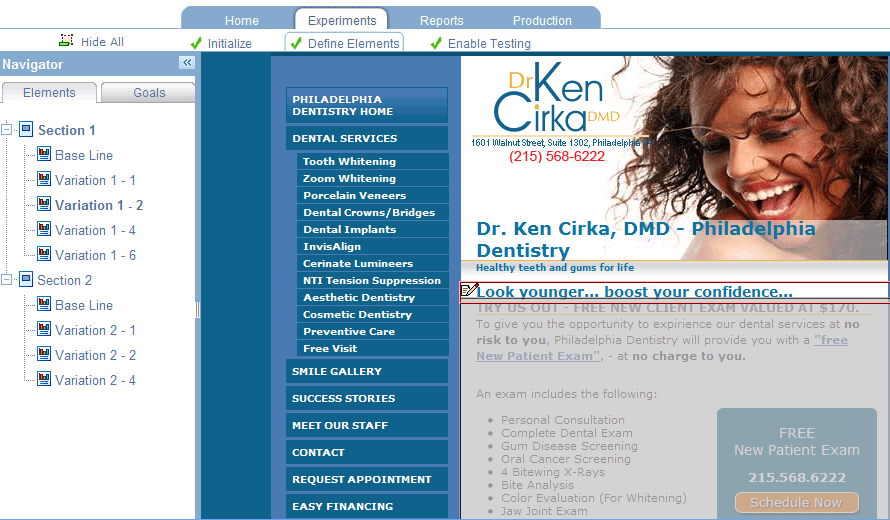
Once the test is defined, we start the test. The software automatically shows the various combinations to visitors, using their browser to display variations on the fly with JavaScript. Search engines only see your original page, so there is no effect on search engine rankings. While the test is running, we can monitor your progress, tracking which combinations yield the highest conversion rates and improvements in ROI.
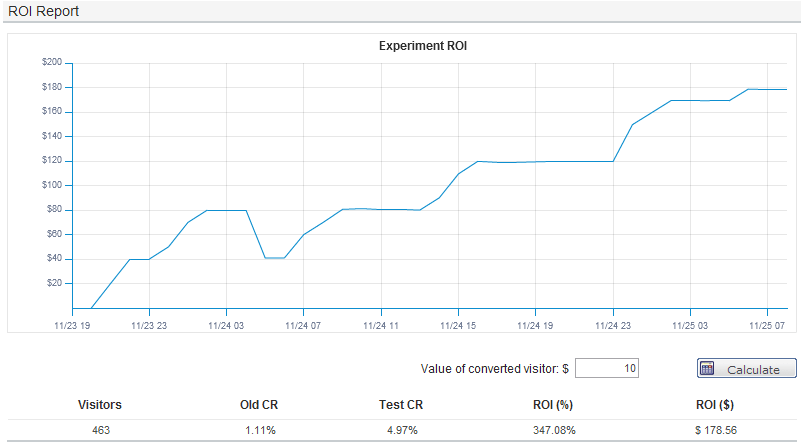
The software automatically favors the combinations that yield the highest conversion rates, quickly finding the optimum solution. You’ll get results faster and be able to run more tests than with conventional conversion rate optimization methods.
Benefits of our Adaptive Conversion Rate Optimization Service
- Faster results – Our self-learning method adapts to find the best combination of web page variables in 1/10 to 1/100 the time!
- Lower traffic requirements – Small to mid-sized sites can now reliably test and optimize landing pages.
- Lower cost – Our turnkey or do-it-yourself solutions are 5 to 10 times less than hiring the other guys.
- Faster profits – You’ll realize higher conversions while the test is running, not after.
- No guesswork – Using a patent-pending self-learning method our software tests different content variations (headlines, page copy, offers, layout, and style) to find which combination gives you the best conversion rates and thus sales. Our adaptive multi-variable split testing takes any guesswork out of conversion rate optimization since the numbers speak for themselves!
- 100% Guarantee – We guarantee our conversion rate strategies will significantly increase your conversion rates.
